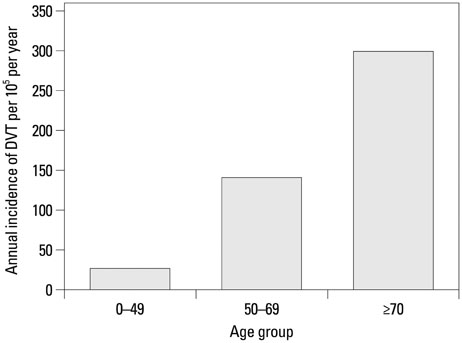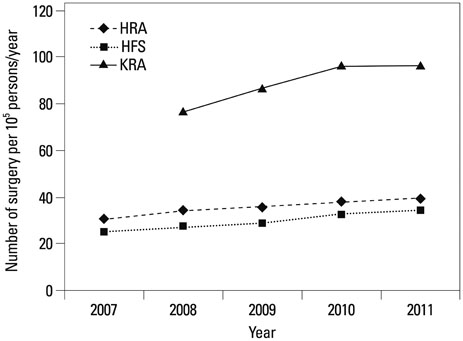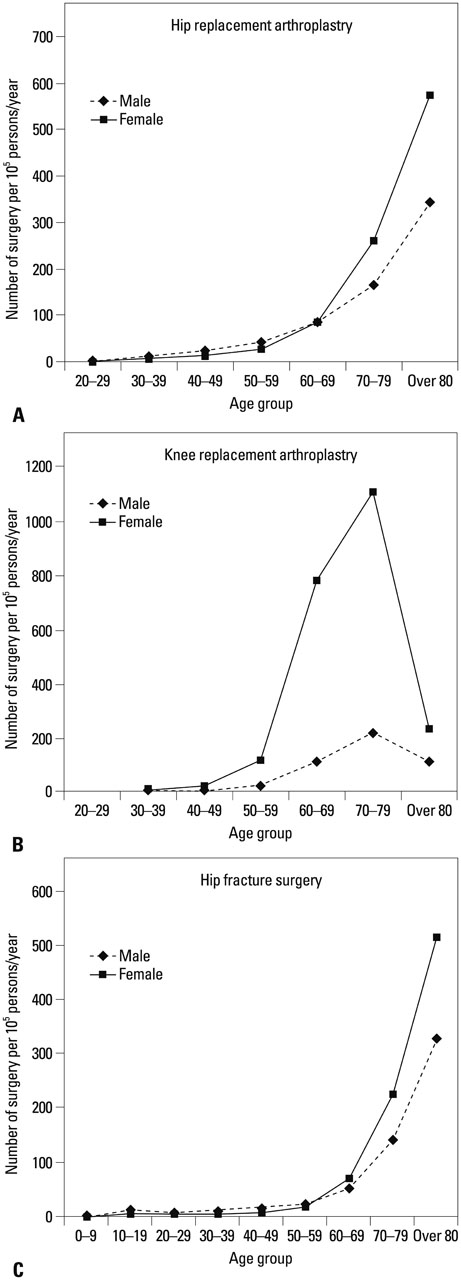Yonsei Med J.
2015 Jan;56(1):139-145. 10.3349/ymj.2015.56.1.139.
Incidence of Deep Vein Thrombosis after Major Lower Limb Orthopedic Surgery: Analysis of a Nationwide Claim Registry
- Affiliations
-
- 1Department of Orthopaedic Surgery, Ewha Womans University Mokdong Hospital, Seoul, Korea.
- 2Department of Orthopaedic Surgery, Seoul National University Bundang Hospital, Seongnam, Korea. pmsmed@gmail.com
- 3Biomedical Research Institute, Seoul National University Bundang Hospital, Seongnam, Korea.
- 4Department of Orthopaedic Surgery, Myongji Hospital, Goyang, Korea.
- KMID: 2352799
- DOI: http://doi.org/10.3349/ymj.2015.56.1.139
Abstract
- PURPOSE
We aimed to evaluate the nationwide incidence and risk factors for symptomatic deep vein thrombosis (DVT) after major lower limb orthopedic surgeries.
MATERIALS AND METHODS
The Korean Health Insurance Review and Assessment Service database was used to retrospectively identify International Classification of Disease-10 codes for DVT and operation codes representing hip arthroplasty, knee arthroplasty, and hip fracture surgeries. The age- and gender-adjusted annual incidence of DVT, rates of major lower limb orthopedic surgeries, and the postoperative incidence of DVT according to the surgical procedure were assessed.
RESULTS
The age- and gender-adjusted annual incidence of DVT was 70.67 per 100000 persons/year. Compared to patients aged <49 years, the relative risk of DVT was five times higher in patients aged 50-69 and 10 times higher in patients aged >70 years (p<0.001). Females showed a greater relative risk for DVT than males (1.08; p<0.001). The incidence of postoperative DVT, according to the type of surgery, was significantly greater for knee replacement arthroplasty than for other forms of surgery (p<0.002). The relative risk of postoperative DVT was higher in females in knee replacement arthroplasty (1.47) and hip fracture surgery (2.25) groups, although relatively lower in those who underwent hip replacement arthroplasty (0.97).
CONCLUSION
Among major lower limb surgeries, advanced age, female gender, and undergoing a knee replacement arthroplasty were found to be risk factors for developing postoperative DVT. These findings further emphasize the need for orthopedic surgeons to consider the development of DVT after surgery in high-risk patients.
MeSH Terms
-
Adolescent
Adult
Age Distribution
Aged
Child
Child, Preschool
Female
Humans
Incidence
Infant
Infant, Newborn
Leg/*surgery
Male
Middle Aged
Orthopedic Procedures/*adverse effects
Postoperative Complications/epidemiology/etiology
Registries/*statistics & numerical data
Republic of Korea/epidemiology
Risk Factors
Venous Thrombosis/*epidemiology/*etiology
Young Adult
Figure
Cited by 1 articles
-
The Efficacy of Low Molecular Weight Heparin for the Prevention of Venous Thromboembolism after Hip Fracture Surgery in Korean Patients
Kwang-Kyoun Kim, Yougun Won, Ye-Yeon Won
Yonsei Med J. 2016;57(5):1209-1213. doi: 10.3349/ymj.2016.57.5.1209.
Reference
-
1. Kucher N. Clinical practice. Deep-vein thrombosis of the upper extremities. N Engl J Med. 2011; 364:861–869.2. Prevention of venous thrombosis and pulmonary embolism. NIH Consensus Development. JAMA. 1986; 256:744–749.3. Cohen AT. Asia-Pacific Thrombosis Advisory Board. Asia-Pacific Thrombosis Advisory Board consensus paper on prevention of venous thromboembolism after major orthopaedic surgery. Thromb Haemost. 2010; 104:919–930.
Article4. Falck-Ytter Y, Francis CW, Johanson NA, Curley C, Dahl OE, Schulman S, et al. Prevention of VTE in orthopedic surgery patients: Antithrombotic Therapy and Prevention of Thrombosis, 9th ed: American College of Chest Physicians Evidence-Based Clinical Practice Guidelines. Chest. 2012; 141:2 Suppl. e278S–e325S.5. Clagett GP, Anderson FA Jr, Heit J, Levine MN, Wheeler HB. Prevention of venous thromboembolism. Chest. 1995; 108:4 Suppl. 312S–334S.
Article6. Piovella F, Wang CJ, Lu H, Lee K, Lee LH, Lee WC, et al. Deep-vein thrombosis rates after major orthopedic surgery in Asia. An epidemiological study based on postoperative screening with centrally adjudicated bilateral venography. J Thromb Haemost. 2005; 3:2664–2670.
Article7. Januel JM, Chen G, Ruffieux C, Quan H, Douketis JD, Crowther MA, et al. Symptomatic in-hospital deep vein thrombosis and pulmonary embolism following hip and knee arthroplasty among patients receiving recommended prophylaxis: a systematic review. JAMA. 2012; 307:294–303.8. Geerts WH, Bergqvist D, Pineo GF, Heit JA, Samama CM, Lassen MR, et al. Prevention of venous thromboembolism: American College of Chest Physicians Evidence-Based Clinical Practice Guidelines (8th Edition). Chest. 2008; 133:6 Suppl. 381S–453S.9. Eikelboom JW, Karthikeyan G, Fagel N, Hirsh J. American Association of Orthopedic Surgeons and American College of Chest Physicians guidelines for venous thromboembolism prevention in hip and knee arthroplasty differ: what are the implications for clinicians and patients? Chest. 2009; 135:513–520.10. Kearon C. Natural history of venous thromboembolism. Circulation. 2003; 107:23 Suppl 1. I22–I30.11. Stein PD, Henry JW. Prevalence of acute pulmonary embolism among patients in a general hospital and at autopsy. Chest. 1995; 108:978–981.
Article12. Kim HA, Kim S, Seo YI, Choi HJ, Seong SC, Song YW, et al. The epidemiology of total knee replacement in South Korea: national registry data. Rheumatology (Oxford). 2008; 47:88–91.
Article13. Warwick D. Prevention of venous thromboembolism in total knee and hip replacement. Circulation. 2012; 125:2151–2155.14. Westrich GH, Sculco TP. Prophylaxis against deep venous thrombosis after total knee arthroplasty. Pneumatic plantar compression and aspirin compared with aspirin alone. J Bone Joint Surg Am. 1996; 78:826–834.
Article15. Douketis JD, Eikelboom JW, Quinlan DJ, Willan AR, Crowther MA. Short-duration prophylaxis against venous thromboembolism after total hip or knee replacement: a meta-analysis of prospective studies investigating symptomatic outcomes. Arch Intern Med. 2002; 162:1465–1471.
Article16. Willis AA, Warren RF, Craig EV, Adler RS, Cordasco FA, Lyman S, et al. Deep vein thrombosis after reconstructive shoulder arthroplasty: a prospective observational study. J Shoulder Elbow Surg. 2009; 18:100–106.17. Madhusudhan TR, Sinha A, Widdowson D. Deep vein thrombosis in shoulder arthroplasty - a prospective study. BMC Musculoskelet Disord. 2013; 14:139.
Article18. Spencer FA, Emery C, Joffe SW, Pacifico L, Lessard D, Reed G, et al. Incidence rates, clinical profile, and outcomes of patients with venous thromboembolism. The Worcester VTE study. J Thromb Thrombolysis. 2009; 28:401–409.
Article19. Naess IA, Christiansen SC, Romundstad P, Cannegieter SC, Rosendaal FR, Hammerstrøm J. Incidence and mortality of venous thrombosis: a population-based study. J Thromb Haemost. 2007; 5:692–699.
Article20. Dowling NF, Austin H, Dilley A, Whitsett C, Evatt BL, Hooper WC. The epidemiology of venous thromboembolism in Caucasians and African-Americans: the GATE Study. J Thromb Haemost. 2003; 1:80–87.21. Jang MJ, Bang SM, Oh D. Incidence of venous thromboembolism in Korea: from the Health Insurance Review and Assessment Service database. J Thromb Haemost. 2011; 9:85–91.
Article22. Silverstein MD, Heit JA, Mohr DN, Petterson TM, O'Fallon WM, Melton LJ 3rd. Trends in the incidence of deep vein thrombosis and pulmonary embolism: a 25-year population-based study. Arch Intern Med. 1998; 158:585–593.23. Goldhaber SZ, Bounameaux H. Pulmonary embolism and deep vein thrombosis. Lancet. 2012; 379:1835–1846.
Article24. Nordström M, Lindblad B, Bergqvist D, Kjellström T. A prospective study of the incidence of deep-vein thrombosis within a defined urban population. J Intern Med. 1992; 232:155–160.
Article25. Robertsson O, Dunbar MJ, Knutson K, Lidgren L. Past incidence and future demand for knee arthroplasty in Sweden: a report from the Swedish Knee Arthroplasty Register regarding the effect of past and future population changes on the number of arthroplasties performed. Acta Orthop Scand. 2000; 71:376–380.
Article26. Dhillon KS, Askander A, Doraismay S. Postoperative deep-vein thrombosis in Asian patients is not a rarity: a prospective study of 88 patients with no prophylaxis. J Bone Joint Surg Br. 1996; 78:427–430.27. Kakkar VV, Howe CT, Flanc C, Clarke MB. Natural history of postoperative deep-vein thrombosis. Lancet. 1969; 2:230–232.28. Terao M, Ozaki T, Sato T. Diagnosis of deep vein thrombosis after operation for fracture of the proximal femur: comparative study of ultrasonography and venography. J Orthop Sci. 2006; 11:146–153.
Article
- Full Text Links
- Actions
-
Cited
- CITED
-
- Close
- Share
- Similar articles
-
- The Incidence of Deep Vein Thrombosis in the Lower Extremity
- Significance of Contrast Enhanced Rapid MR Sequence(True FISP) in Deep Vein Thrombosis
- A Case of Deep Vein Thrombosis in Common Iliac Vein after Arthroscopic Partial Meniscectomy
- Acute Compartment Syndrome after Anticoagulant Therapy to Misdiagnosed Deep Vein Thrombosis
- Incidence and Clinical Significance of Deep Vein Thrombosis after Cementless Total Hip Replacement in Korean Patient Population





